With more than 50 recognized types of chickens, there are some awesome-looking varieties out there!
From beautifully colored and textured feathers to bizarre feathery feet, their traits vary wildly from breed to breed.
Some chicken breeds even have crazy “hair” (actually uniquely textured feathers), which gives them a fun, unique, and memorable appearance.
Let’s take a look at 10 breeds of chickens with the craziest, funkiest hairdos!
Table of Contents
ToggleSilkie
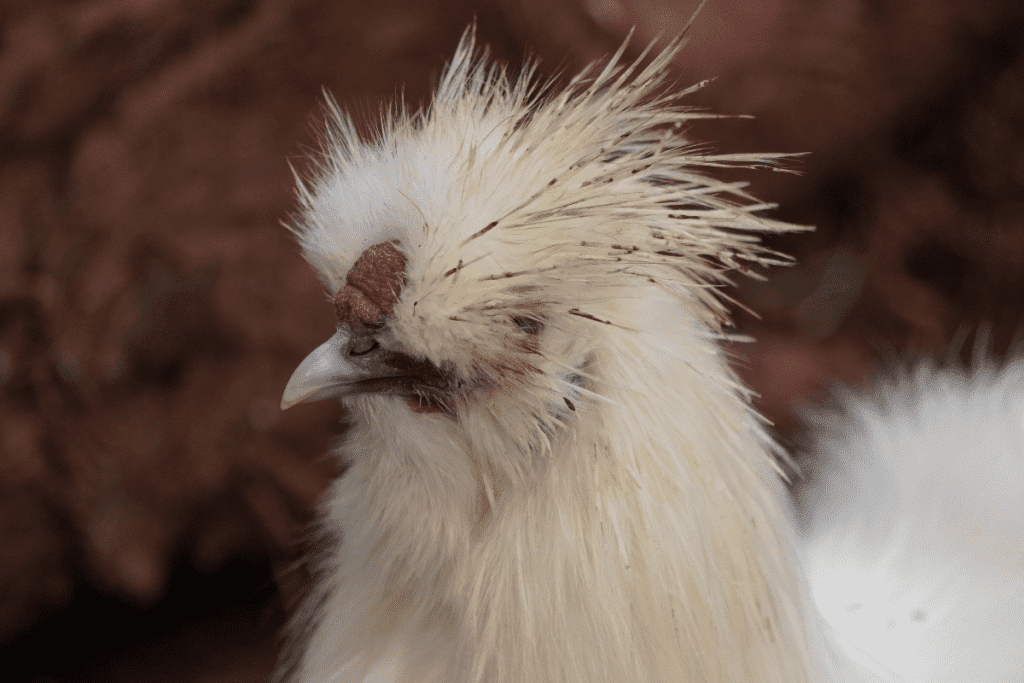
One of the more well-known chicken breeds with fun hair is the impossibly fluffy and soft Silkie! Thanks to their lack of barbicels, its feathers have a distinctly “hairy” appearance.
Barbicels are small hooked filaments connected, which gives chickens’ and other birds’ feathers their typical structure.
Without these barbicels, the feathers are loose, soft, and flowy, sort of like down feathers.
Silkie chickens are also notable and especially well-loved for their fluffy plumes atop their heads, which also lack barbicels and look a lot like Albert Einstein’s wild mane!
Sometimes, this feathery mass even partially hangs down and covers the chickens’ eyes, giving them a sort of edgy, emo look.
These funky chickens exist in a wide range of colors, from the classic, solid white commonly seen amongst prized show chickens to varying brown, red, and black shades.
There are even two different varieties of Silkies, bearded and non-bearded!
As their name suggests, the bearded ones have an additional bundle of loose, flowy feathers under their chins and around their ears.
Among other interesting qualities about Silkies is their skin tone, either a ghostly bluish-grey or solid black.
They’re also known for being polydactyl or having extra toes on their feet!
Nowadays, these chickens are a favorite amongst hobby farmers, as Silkies have curious, docile temperaments that perfectly complement their adorable appearance.
Check out the Silkie rooster care guide we have on our site.
Polish
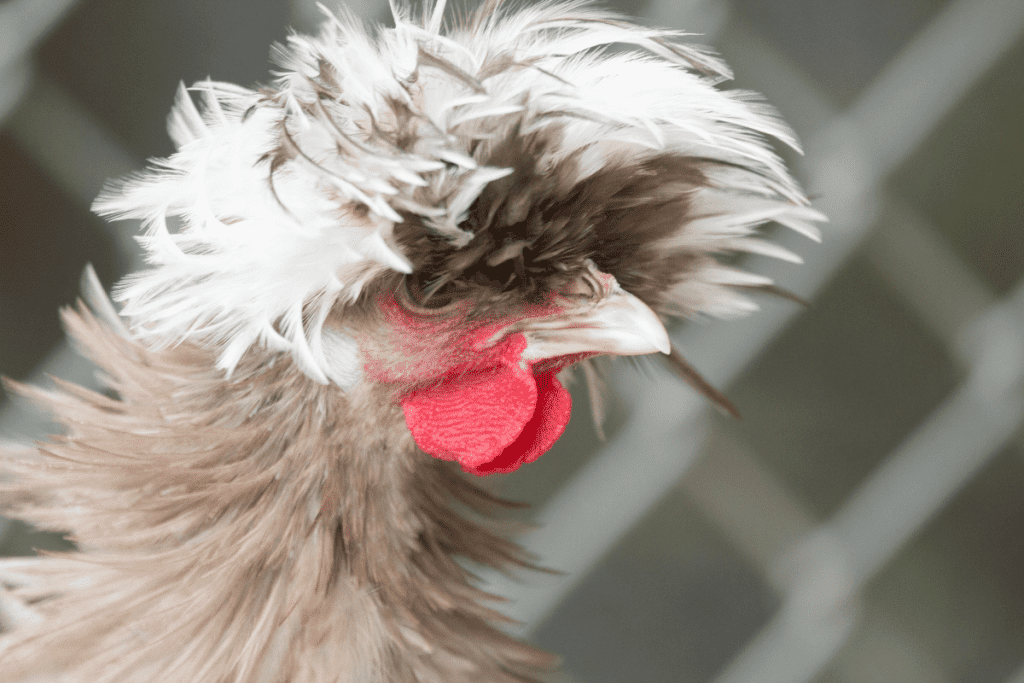
The Polish chicken is a crested chicken, a group of birds with fluffy crests of soft, long feathers atop their heads!
These crests range in shapes, textures, colors, and sizes, but Polish chickens tend to have a full, rounded crest of thin, sleek feathers.
Despite their name, Polish chickens were likely originally native to the Netherlands.
Still, a lot of the details of their history and the breed’s development sadly aren’t very well-documented.
Today, the Polish is a common show breed, primarily thanks to its adorable rocker hairstyle.
Polish chickens have unique hair and uniquely-shaped combs, which tend to present in a U or V shape rather than the typical upright, notched comb shape.
Their feathers and comb tend to hang down over their eyes, which makes them a bit fearful since they aren’t able to see as well as other chickens lacking this massive, feathery crest.
Interestingly, there are bearded varieties of Polish chickens, too!
There are even frizzle/Polish chickens, and we’ll cover the frizzle breed specifically in more detail below.
In addition to being a popular show breed, Polish chickens have become common pets, in part due to their unique look but also thanks to their fairly docile yet timid disposition.
Frizzle
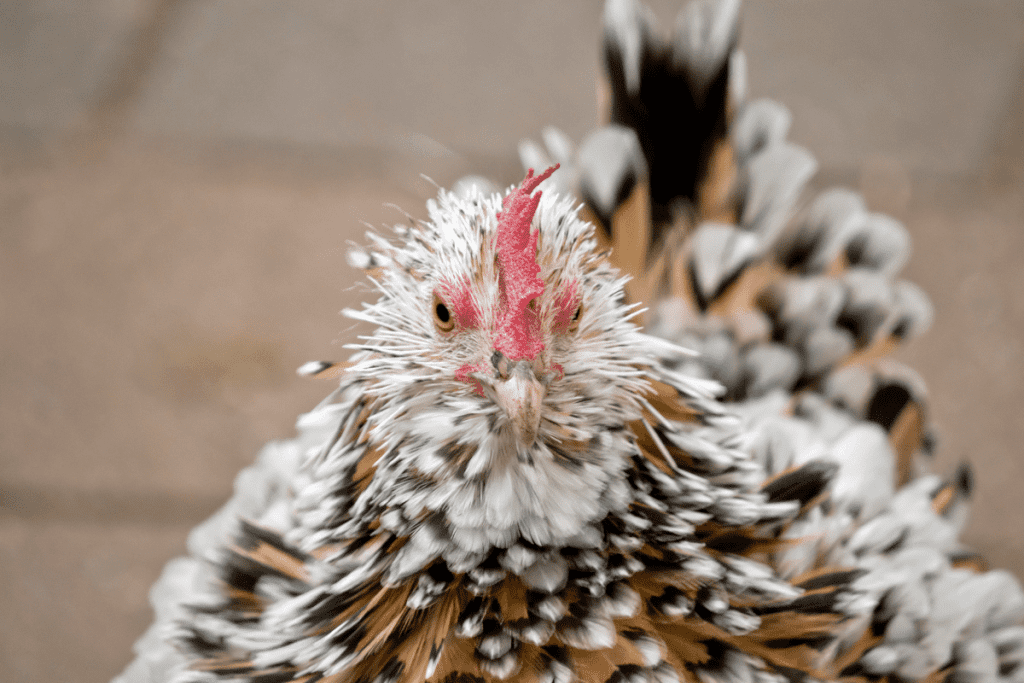
The Frizzle’s name suits it perfectly, as its feathers look, well, frizzy!
These chickens’ curly feathers splay out in a flared arc from their bodies, making the chickens look super fluffy and incredibly unique.
Even the smaller feathers on their heads have this flared look, which often gives them adorably silly-looking “hair” sticking straight up.
Like many of the other breeds on this list, the Frizzle chicken has plenty of color variation, from white and black to mixtures of red, brown, orange, and tan.
The Frizzle gets its trademark fuzzy feathers from what researchers believe is a mutation within a particular keratin gene.
Keratin is the material that makes up our hair and nails and most animals’ scales, claws, feathers, horns, and hair.
Also similar to most of the funky-looking breeds listed here, Frizzles are an extremely popular show breed.
They’re also now kept as pets by hobby farmers everywhere, as they are docile and very hardy.
The Frizzle has even been crossed with other breeds, including the aforementioned Polish.
Related: 500+ Top Rooster Name Ideas.
Araucana
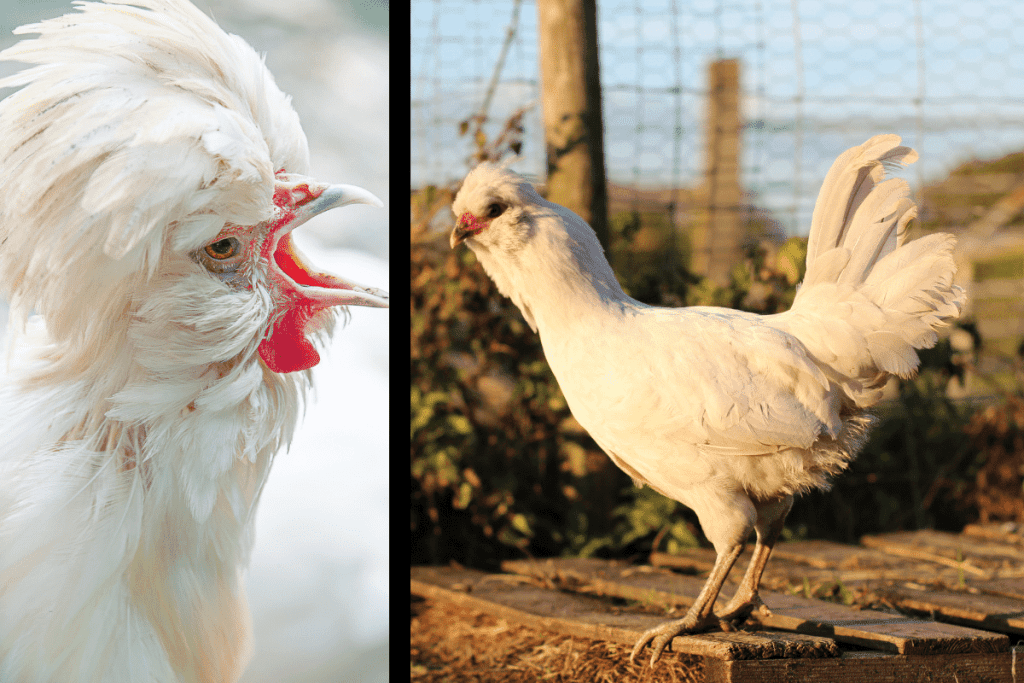
The Araucana chicken breed is known for its flared tufts of feathers on the sides of its head just below its earlobes.
These tufts of feathers look a lot like a beard or sideburns, giving the chickens an amusing appearance.
These chickens are also “rumpless,” meaning the breed lacks prominent tail feathers.
This particular breed originated in Chile’s Araucania region, and it quickly spread from there and became a popular pet and show breed.
Aside from their unusual hairdo and lack of noticeable tail feathers, Araucana chickens are popular for their bright blue eggs!
While they don’t taste different from a typical white or brown chicken egg, they’re still beautiful and unique.
This quality has given them the “Easter egger” distinction shared by other breeds which lay blue or green eggs.
Though the breed has a rich history, it didn’t become very popular in the pet trade and exhibitions until the 1980s.
There is also the Ameraucana variant, which is not rumpless and has a feathery beard and ear tufts.
They’re available now in a wide assortment of colors and patterns, from black and white and brown to greyish lavender.
Crevecoeur
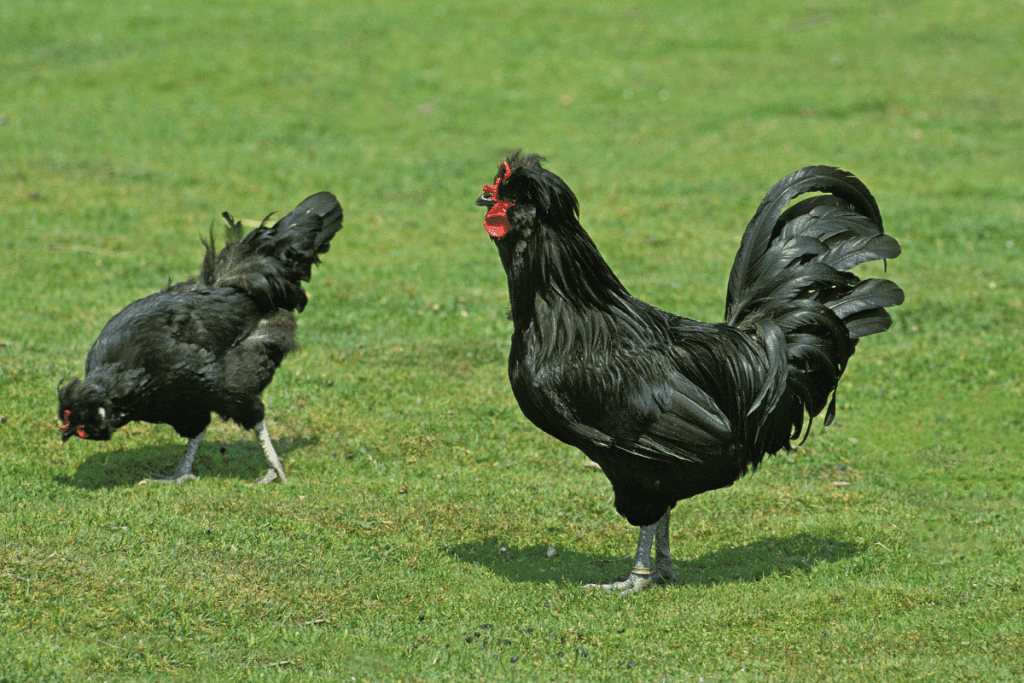
The Crevecoeur breed is endangered and quite rare!
These chickens look like a mixture of the Silkie and the Polish breeds due to their fluffy little crest feathers on their heads and soft “beard” feathers under their beaks.
Their combs are U-shaped and resemble tiny red horns, and the typical plumage coloration is solid, sleek black, giving them an almost menacing appearance.
Their beaks and eyes are usually black, but some individuals have uniquely red eyes!
While black is the most common body color, there are also the lesser-known white and bluish variants.
As its fancy, dignified French name would suggest, the Crevecoeur chicken is native to northwestern France near Normandy.
Notably, it is related to the handsome, also-French La Fleche breed.
These chickens are useful as egg and meat birds and are quite hardy.
Unfortunately, their diminishing numbers and rarity are mostly only bred for exhibition purposes nowadays.
It’s a historic breed with a long, rich history dating back to the 1800s, but sadly, without proper conservation, its history will likely end in the near future.
Poule de Houdan
Another very old French breed with its signature ‘do is the Houdan chicken, also known as the Poule de Houdan.
Their wild feathery crests atop their heads are accentuated by their massive, V-shaped or “butterfly” double combs, which protrude from their foreheads almost like horns or oddly-shaped antlers.
The males’ combs are massive, while the females’ much smaller combs are usually covered up by their feathered crests.
These handsome chickens have been used for their meat and eggs in the past, but today, they’re usually used solely as show chickens or kept as beloved pets by hobby farmers.
The Houdan’s history isn’t very well documented, but researchers and historians believe it originated sometime during or before the 1800s.
It has been crossbred with other specialty show breeds, such as Crevecoeur and Polish varieties previously mentioned.
Interestingly, they have five toes on their feet rather than the typical four present on most chicken breeds.
Color-wise, the Houdan is quite varied.
There are solid-colored Houdan chickens and those with a mixture of black, white, and grey feathers, which is most commonly known as the mottled or pebbled coloration.
Brabanter/Brabanconne
The Brabanter or Brabanconne chicken is a Dutch variety native to Belgium and the Netherlands.
The breed’s most well-known and loved trait is its wild “hair,” made up of many thin, long feathers poking straight out in all different directions.
This historic breed is notable for its V-shaped comb and prominent crest of feathers on its head and its wide range of colors and patterns!
There are a whopping 13 recognized color variants!
And they’ve even been crossbred with other unique breeds, including a smaller, bantam variety.
These chickens are very popular for their consistent egg production, even in the winter when most other breeds lay very few eggs.
Though their comb has a unique V shape, it is smaller than most other breeds with the same comb style, making it particularly hardy during the winter and less prone to experiencing frostbite as the Polish or Houdan mentioned above.
In addition to their amusing yet handsome appearance and ability to produce many eggs throughout the year, the Brabanter breed is a common pet for its smart yet calm demeanor and friendly attitude.
They hold up very well in colder climates and warmer areas, so it’s possible to keep them in a wide range of locations thanks to the breed’s hardiness.
Sultan
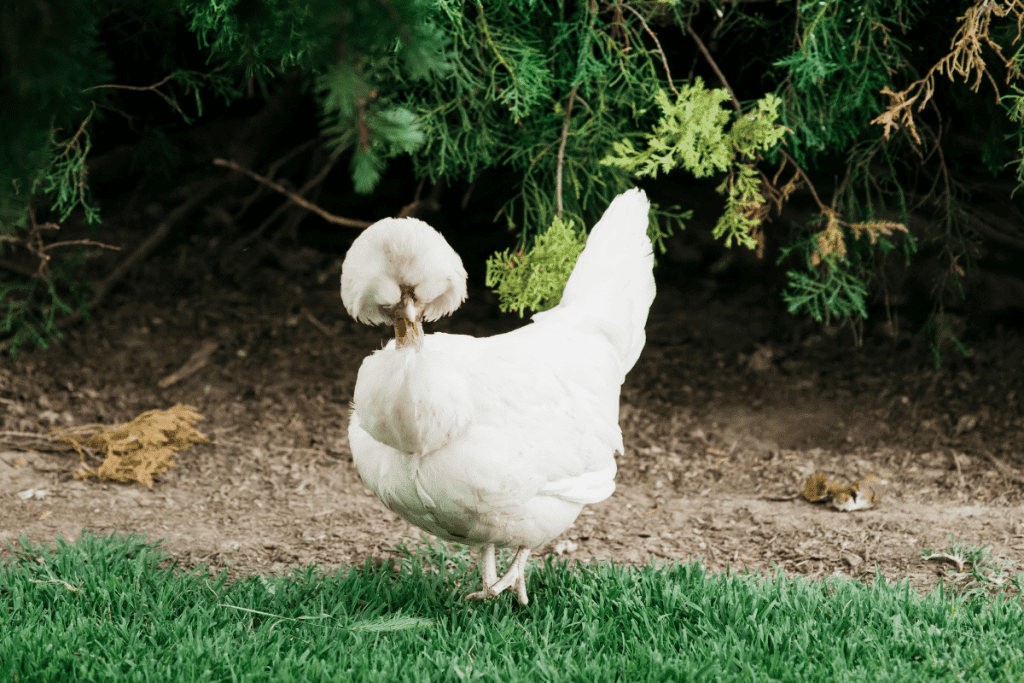
The Sultan breed’s royal name suits it well, as these chickens look incredibly ornate thanks to their (usually) solid white color, soft, round crown-like crests of feathers on their heads, long tail feathers, and their heavily feathered feet.
Native to Turkey, the breed is almost solely kept as pets or as show birds rather than used for eggs or meat.
Sultan chickens are rare and not particularly widespread in the pet trade, though they are admired and coveted by farmers everywhere looking to adopt one (or a few) of their own.
Though they were originally limited to parts of Turkey, they were eventually exported to other countries, including the United States, in the mid-1800s.
Like many other breeds on this list, Sultan chickens have V-shaped combs.
However, theirs are quite small compared to other breeds with the same comb shape, and the comb is typically barely or not at all visible under the massive, round crest on the chickens’ heads.
While white is the most common and most loved color amongst Sultan chickens, there are also black and bluish varieties and a smaller bantam breed.
These medium-sized birds have five toes instead of the typical four on each foot, but it’s hard to see their toes at all due to the long feathers adorning their feet.
Further Reading: What do Sultan chickens like to eat?
Padovana
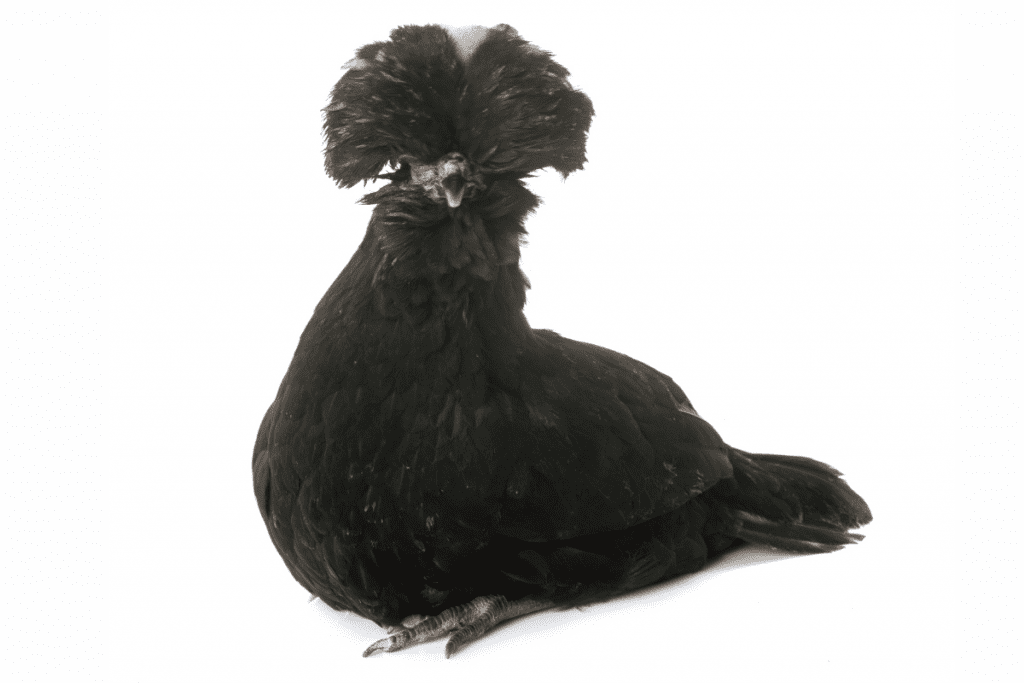
Also known as the Padovana dal gran ciuffo (literally meaning “large-crested Paduan”), the Padovana is an Italian breed with a rich history possibly dating back to the 1300s!
Unfortunately, the breed’s history isn’t very well documented this far back, so it’s hard to pinpoint exactly when or where they originated for sure.
The Padovana is mostly kept for exhibitions or as a pet by hobby farmers, but it is quite rare and difficult to find as its numbers have diminished to just a thousand or so individuals.
There is a wide range of possible colors and patterns, from solid white or black to uniquely patterned gold- and silver-laced varieties.
Interestingly, these chickens have no combs to speak of, and their wattles are also so tiny they’re nonexistent.
Their crest of feathers on their heads covers their ears and eyes almost entirely, which sometimes obscures their vision.
Naked Neck/Turken
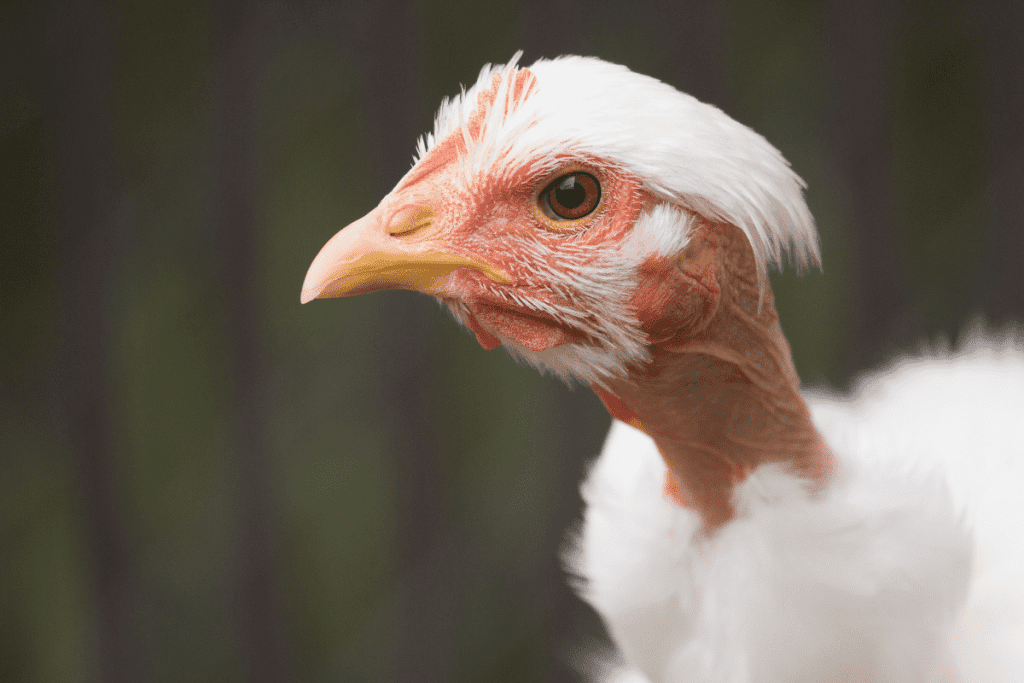
While most of the chicken breeds on this list have large crests of fluffy feathers, the Naked Neck (also sometimes known as the Transylvanian Naked Neck or simply the “Turken” for its turkey-like neck) chicken is notable for its lack of “hair” on its head, neck, and vent.
These chickens look bizarre, but they also have a unique charm that makes them popular pets throughout Europe, South America, and even America.
They’ve been crossbred with many other breeds to pass on this odd “naked neck” trait, but strangely, they aren’t very common in exhibitions.
Fortunately, the Naked Neck chicken is useful for meat and brown eggs.
It is especially popular for meat since it doesn’t need to be plucked beforehand like most other breeds.
Despite the absence of feathers on its head and neck, it’s quite hardy in cold climates, so they’ve become pretty common pets in recent years.
How useful was this post?
Click on a star to rate it!
We are sorry that this post was not useful for you!
Let us improve this post!
Tell us how we can improve this post?
